Spatiotemporal Heterogeneity and Driving Mechanism of Co-Ordinated Urban Development: A Case Study of the Central Area of the Yangtze River Delta, China
Abstract
:1. Introduction
2. Materials and Methods
2.1. Materials
2.1.1. Study Area
2.1.2. Data Sources
2.2. Research Method
2.2.1. Construction of Evaluation Index System
2.2.2. Extraction of Urban Built-Up Area
2.2.3. Coupling Coordination Model
2.2.4. Standard Deviation Ellipse Model
2.2.5. Geographically and Temporally Weighted Regression Model
3. Results
3.1. Spatiotemporal Characteristics of Coordinated Urbanization Development
3.1.1. Temporal Characteristics Analysis
3.1.2. Spatial Characteristics Analysis
3.2. Analysis of Driving Factors and Their Spatiotemporal Distribution of Coordinated Urbanization Development
3.2.1. Calculation Results with GTWR
3.2.2. Analysis of Spatiotemporal Variation of Driving Factors
4. Discussions
4.1. Spatiotemporal Variation of Coordinated Urbanization Development
4.1.1. Time Characteristics
4.1.2. Spatial Characteristics
4.2. Characteristics of Driving Factors
4.3. Development Suggestions
5. Conclusions
Author Contributions
Funding
Institutional Review Board Statement
Informed Consent Statement
Data Availability Statement
Acknowledgments
Conflicts of Interest
References
- Deng, X.; Huang, J.; Rozelle, S.; Zhang, J.; Li, Z. Impact of urbanization on cultivated land changes in China. Land Use Policy 2015, 45, 1–7. [Google Scholar] [CrossRef]
- Chen, M.; Liu, W.; Lu, D. Challenges and the way forward in China’s new-type urbanization. Land Use Policy 2016, 55, 334–339. [Google Scholar] [CrossRef]
- Chen, M.; Liu, W.; Tao, X. Evolution and assessment on China’s urbanization 1960–2010: Under-urbanization or over-urbanization? Habitat Int. 2013, 38, 25–33. [Google Scholar] [CrossRef]
- Lu, D.; Chen, M. Several viewpoints on the background of compiling the “National New Urbanization Planning (2014–2020)”. Acta Geogr. Sin. 2015, 70, 179–185. [Google Scholar]
- Wang, X.-R.; Hui, E.C.-M.; Choguill, C.; Jia, S.-H. The new urbanization policy in China: Which way forward? Habitat Int. 2015, 47, 279–284. [Google Scholar] [CrossRef]
- Shen, L.; Zhou, J. Examining the effectiveness of indicators for guiding sustainable urbanization in China. Habitat Int. 2014, 44, 111–120. [Google Scholar] [CrossRef]
- Liu, Y.; Liu, Y.; Chen, Y.; Long, H. The process and driving forces of rural hollowing in China under rapid urbanization. J. Geogr. Sci. 2010, 20, 876–888. [Google Scholar] [CrossRef]
- Zheng, W.; Walsh, P.P. Economic growth, urbanization and energy consumption—A provincial level analysis of China. Energy Econ. 2019, 80, 153–162. [Google Scholar] [CrossRef]
- John, F. Four Theses in the Study of China’s Urbanization. Int. J. Urban Reg. Res. 2006, 30, 440–451. [Google Scholar]
- Zhang, L.; Zhao, S.X. Reinterpretation of China’s under-urbanization: A systemic perspective. Habitat Int. 2003, 27, 459–483. [Google Scholar] [CrossRef]
- Lin, G.C.S. Peri-urbanism in Globalizing China: A Study of New Urbanism in Dongguan. Eurasian Geogr. Econ. 2013, 47, 28–53. [Google Scholar] [CrossRef]
- Chen, A.; Gao, J. Urbanization in China and the Coordinated Development Model—The case of Chengdu. Soc. Sci. J. 2019, 48, 500–513. [Google Scholar] [CrossRef]
- Sun, P.; Song, W.; Xiu, C.; Liang, Z. Non-coordination in China’s urbanization: Assessment and affecting factors. Chin. Geogr. Sci. 2013, 23, 729–739. [Google Scholar] [CrossRef] [Green Version]
- Lin, Y.; Li, Y.; Ma, Z. Exploring the Interactive Development between Population Urbanization and Land Urbanization: Evidence from Chongqing, China (1998–2016). Sustainability 2018, 10, 1741. [Google Scholar] [CrossRef] [Green Version]
- Han, H.; Li, H. Coupling Coordination Evaluation between Population and Land Urbanization in Ha-Chang Urban Agglomeration. Sustainability 2020, 12, 357. [Google Scholar] [CrossRef] [Green Version]
- Lv, T.; Wang, L.; Zhang, X.; Xie, H.; Lu, H.; Li, H.; Liu, W.; Zhang, Y. Coupling Coordinated Development and Exploring Its Influencing Factors in Nanchang, China: From the Perspectives of Land Urbanization and Population Urbanization. Land 2019, 8, 178. [Google Scholar] [CrossRef] [Green Version]
- Ma, L.; Cheng, W.; Qi, J. Coordinated evaluation and development model of oasis urbanization from the perspective of new urbanization: A case study in Shandan County of Hexi Corridor, China. Sustain. Cities Soc. 2018, 39, 78–92. [Google Scholar] [CrossRef]
- Lu, D. Function orientation and coordinating development of subregions within the Jing-Jin-Ji Urban Agglomeration. Progr. Geogr. 2015, 34, 265–270. [Google Scholar]
- Zhang, Y.; Su, Z.; Li, G.; Zhuo, Y.; Xu, Z. Spatial-Temporal Evolution of Sustainable Urbanization Development: A Perspective of the Coupling Coordination Development Based on Population, Industry, and Built-Up Land Spatial Agglomeration. Sustainability 2018, 10, 1766. [Google Scholar] [CrossRef] [Green Version]
- Li, Y.; Li, Y.; Zhou, Y.; Shi, Y.; Zhu, X. Investigation of a coupling model of coordination between urbanization and the environment. J. Environ. Manag. 2012, 98, 127–133. [Google Scholar] [CrossRef]
- Guo, Y.; Wang, H.; Nijkamp, P.; Xu, J. Space–time indicators in interdependent urban–environmental systems: A study on the Huai River Basin in China. Habitat Int. 2015, 45, 135–146. [Google Scholar] [CrossRef]
- Wang, Z.; Liang, L.; Sun, Z.; Wang, X. Spatiotemporal differentiation and the factors influencing urbanization and ecological environment synergistic effects within the Beijing-Tianjin-Hebei urban agglomeration. J. Environ. Manag. 2019, 243, 227–239. [Google Scholar] [CrossRef] [PubMed]
- Xu, D.; Hou, G. The Spatiotemporal Coupling Characteristics of Regional Urbanization and Its Influencing Factors: Taking the Yangtze River Delta as an Example. Sustainability 2019, 11, 822. [Google Scholar] [CrossRef] [Green Version]
- Fotheringham, A.S.; Crespo, R.; Yao, J. Geographical and Temporal Weighted Regression (GTWR). Geogr. Anal. 2015, 47, 431–452. [Google Scholar] [CrossRef] [Green Version]
- Mirzaei, M.; Amanollahi, J.; Tzanis, C.G. Evaluation of linear, nonlinear, and hybrid models for predicting PM2.5 based on a GTWR model and MODIS AOD data. Air. Qual. Atmos. Health 2019, 12, 1215–1224. [Google Scholar] [CrossRef]
- Ge, L.; Zhao, Y.; Sheng, Z.; Wang, N.; Zhou, K.; Mu, X. Construction of a Seasonal Difference-Geographically and Temporally Weighted Regression (SD-GTWR) Model and Comparative Analysis with GWR-Based Models for Hemorrhagic Fever with Renal Syndrome (HFRS) in Hubei Province (China). Int. J. Environ. Res. Public Health 2016, 13, 1062. [Google Scholar] [CrossRef] [Green Version]
- Wang, H.; Zhang, B.; Liu, Y.; Liu, Y.; Xu, S.; Zhao, Y.; Chen, Y.; Hong, S. Urban expansion patterns and their driving forces based on the center of gravity-GTWR model: A case study of the Beijing-Tianjin-Hebei urban agglomeration. J. Geograph. Sci. 2020, 30, 297–318. [Google Scholar] [CrossRef]
- NOAA National Centers for Environmental Information (NCEI). Available online: https://www.ngdc.noaa.gov (accessed on 17 April 2022).
- Jing, C.; Tao, H.; Jiang, T.; Wang, Y.; Zhai, J.; Cao, L.; Su, B. Population, urbanization and economic scenarios over the Belt and Road region under the Shared Socioeconomic Pathways. J. Geograph. Sci 2020, 30, 68–84. [Google Scholar] [CrossRef] [Green Version]
- Avtar, R.; Tripathi, S.; Aggarwal, A.K.; Kumar, P. Population–Urbanization–Energy Nexus: A Review. Resources 2019, 8, 136. [Google Scholar] [CrossRef] [Green Version]
- Bian, J.; Li, A.; Lei, G.; Zhang, Z.; Nan, X.; Liang, L. Inter-Calibration of Nighttime Light Data Between DMSP/OLS And NPP/VIIRS in the Economic Corridors of Belt And Road Initiative. In Proceedings of the IGARSS 2019–2019 IEEE International Geoscience and Remote Sensing Symposium, Yokohama, Japan, 28 July–2 August 2019; pp. 9028–9031. [Google Scholar]
- Tan, Y.; Wu, P.; Zhou, G.; Li, Y.; Bai, B. Combining Residual Neural Networks and Feature Pyramid Networks to Estimate Poverty Using Multisource Remote Sensing Data. IEEE J. Sel. Top. Appl. Earth Obs. Remote Sens. 2020, 13, 553–565. [Google Scholar] [CrossRef]
- Huang, W.; Wang, R.; Zu, S.; Chen, Y. Low-frequency noise attenuation in seismic and microseismic data using mathematical morphological filtering. Geophys. J. Int. 2017, 211, 1296–1318. [Google Scholar] [CrossRef]
- Huang, W.; Wang, R.; Zhang, D.; Zhou, Y.; Yang, W.; Chen, Y. Mathematical morphological filtering for linear noise attenuation of seismic data. Geophysics. 2017, 82, V369–V384. [Google Scholar] [CrossRef]
- Wang, D.; Sun, F. Geographic Patterns and Coupling-coordination Between Urbanization and Land Transportation Accessibility in the Yangtze River Economic Zone. Sci. Geogr. Sin. 2018, 38, 1089–1097. [Google Scholar]
- Ding, L.; Zhao, W.; Huang, Y.; Cheng, S.; Liu, C. Research on the Coupling Coordination Relationship between Urbanization and the Air Environment: A Case Study of the Area of Wuhan. Atmosphere 2015, 6, 1539–1558. [Google Scholar] [CrossRef] [Green Version]
- Kent, J.; Leitner, M. Efficacy of standard deviational ellipses in the application of criminal geographic profiling. J. Investig. Psychol. 2007, 4, 147–165. [Google Scholar] [CrossRef]
- Wang, B.; Shi, W.; Miao, Z. Confidence analysis of standard deviational ellipse and its extension into higher dimensional euclidean space. PLoS ONE 2015, 10, e0118537. [Google Scholar] [CrossRef]
- Ceccato, P.; Vancutsem, C.; Klaver, R.; Rowland, J.; Connor, S.J. A vectorial capacity product to monitor changing malaria transmission potential in epidemic regions of Africa. Malaria J. 2012, 2012, 595948. [Google Scholar] [CrossRef] [Green Version]
- Yang, T.-C.; Shoff, C.; Matthews, S.A. Examining the spatially non-stationary associations between the second demographic transition and infant mortality: A Poisson GWR approach. Spat. Demogr. 2013, 1, 17–40. [Google Scholar] [CrossRef] [Green Version]
- Huang, B.; Wu, B.; Barry, M. Geographically and temporally weighted regression for modeling spatio-temporal variation in house prices. Int. J. Geogr. Inf. Sci. 2010, 24, 383–401. [Google Scholar] [CrossRef]

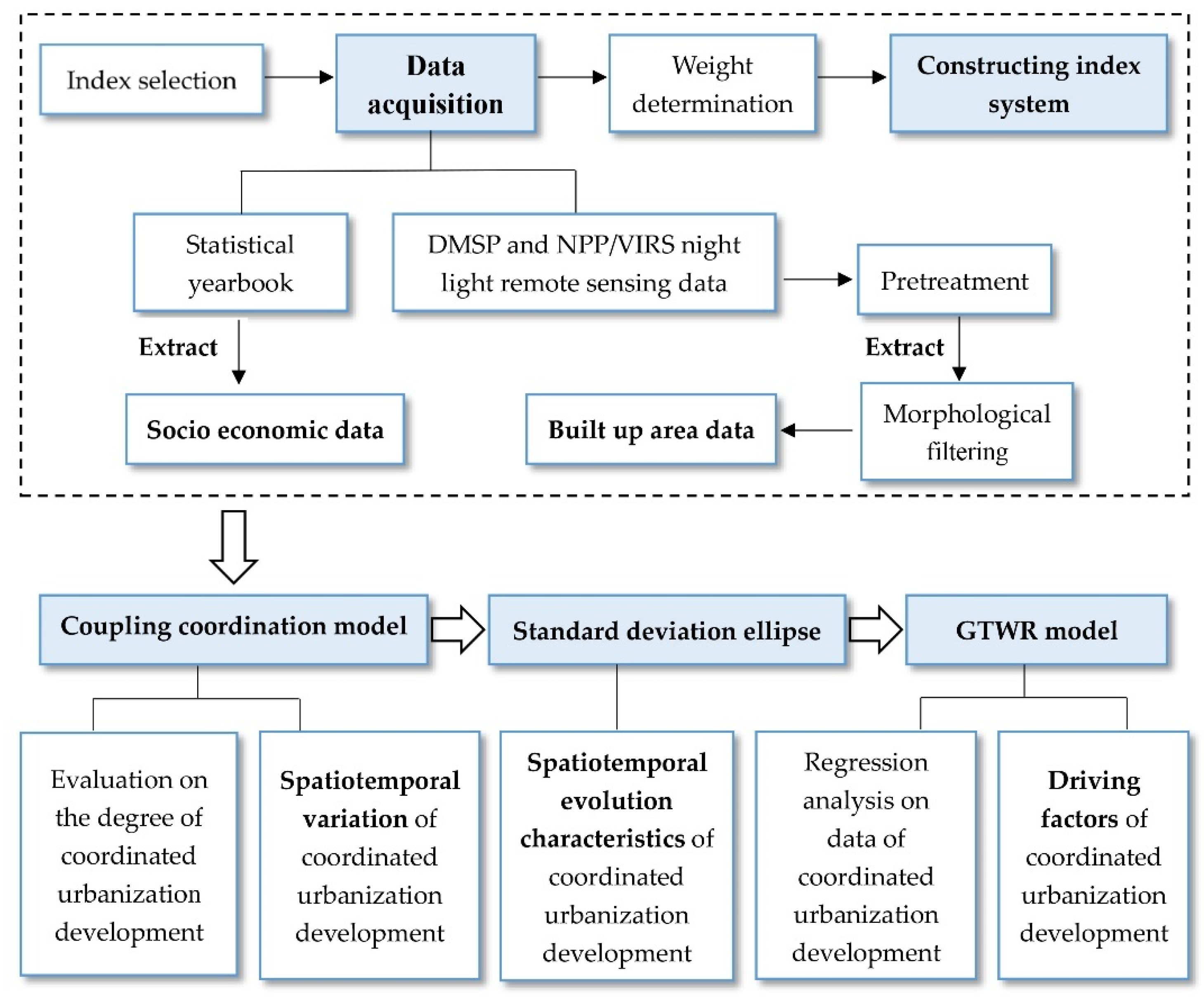
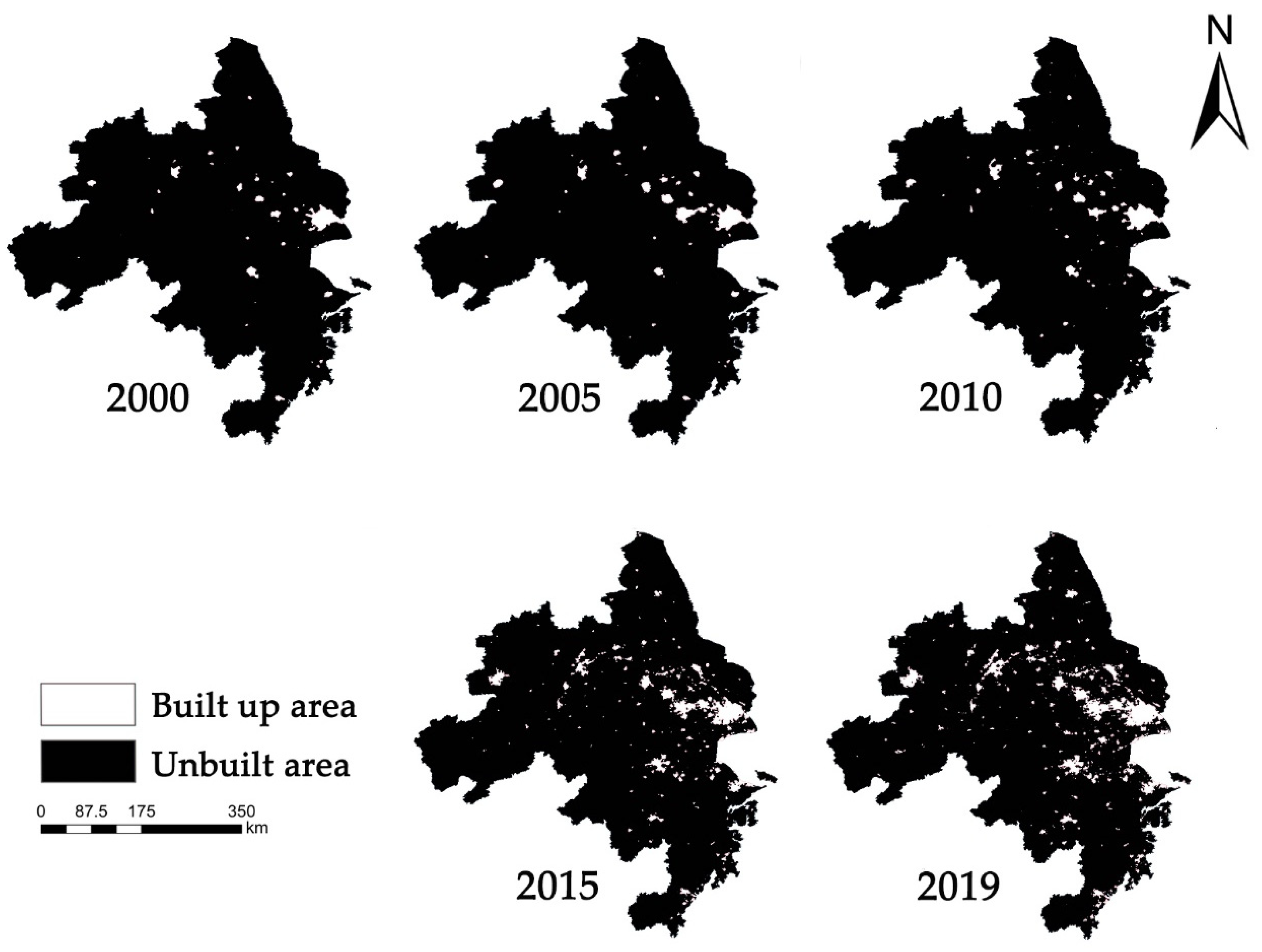
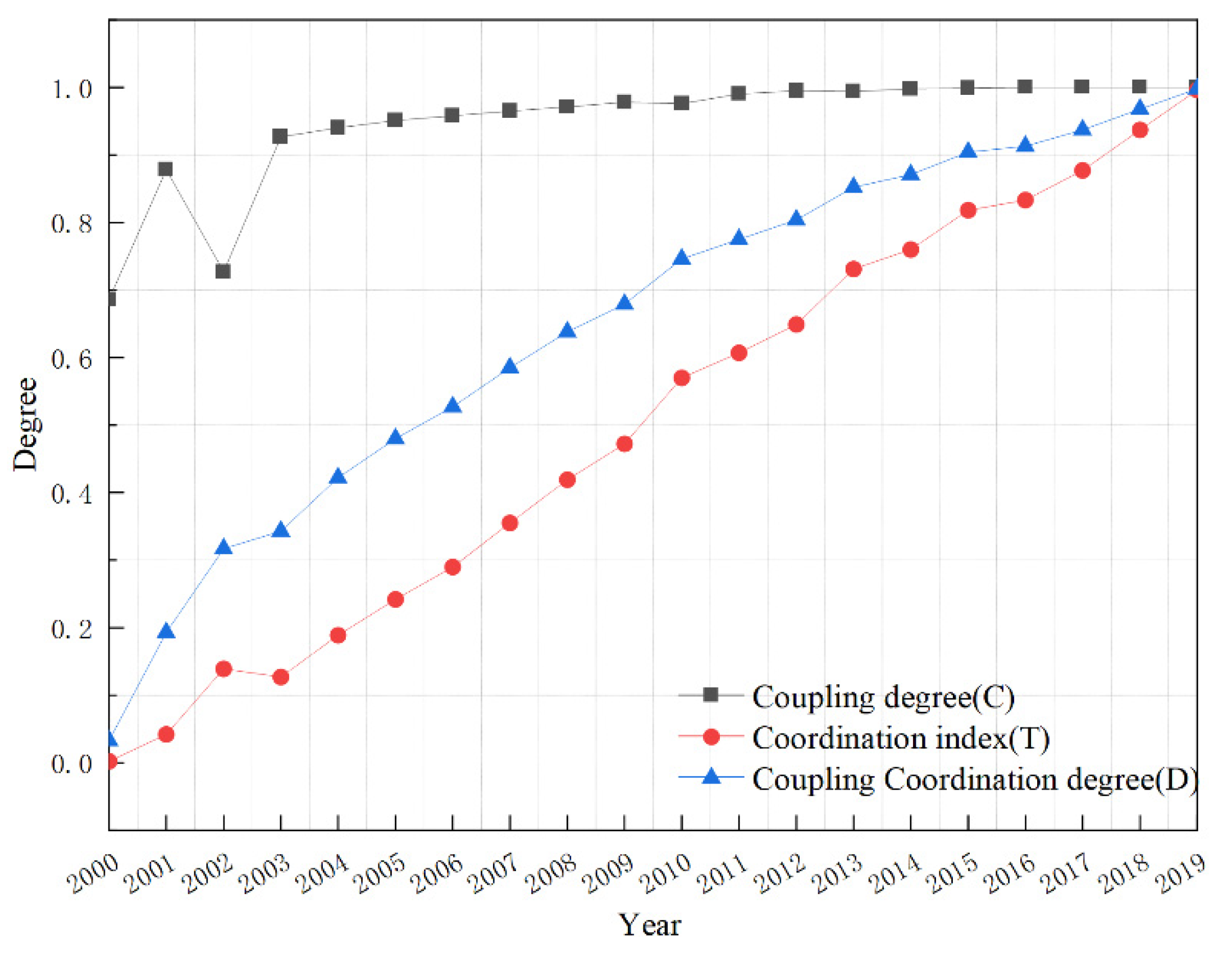
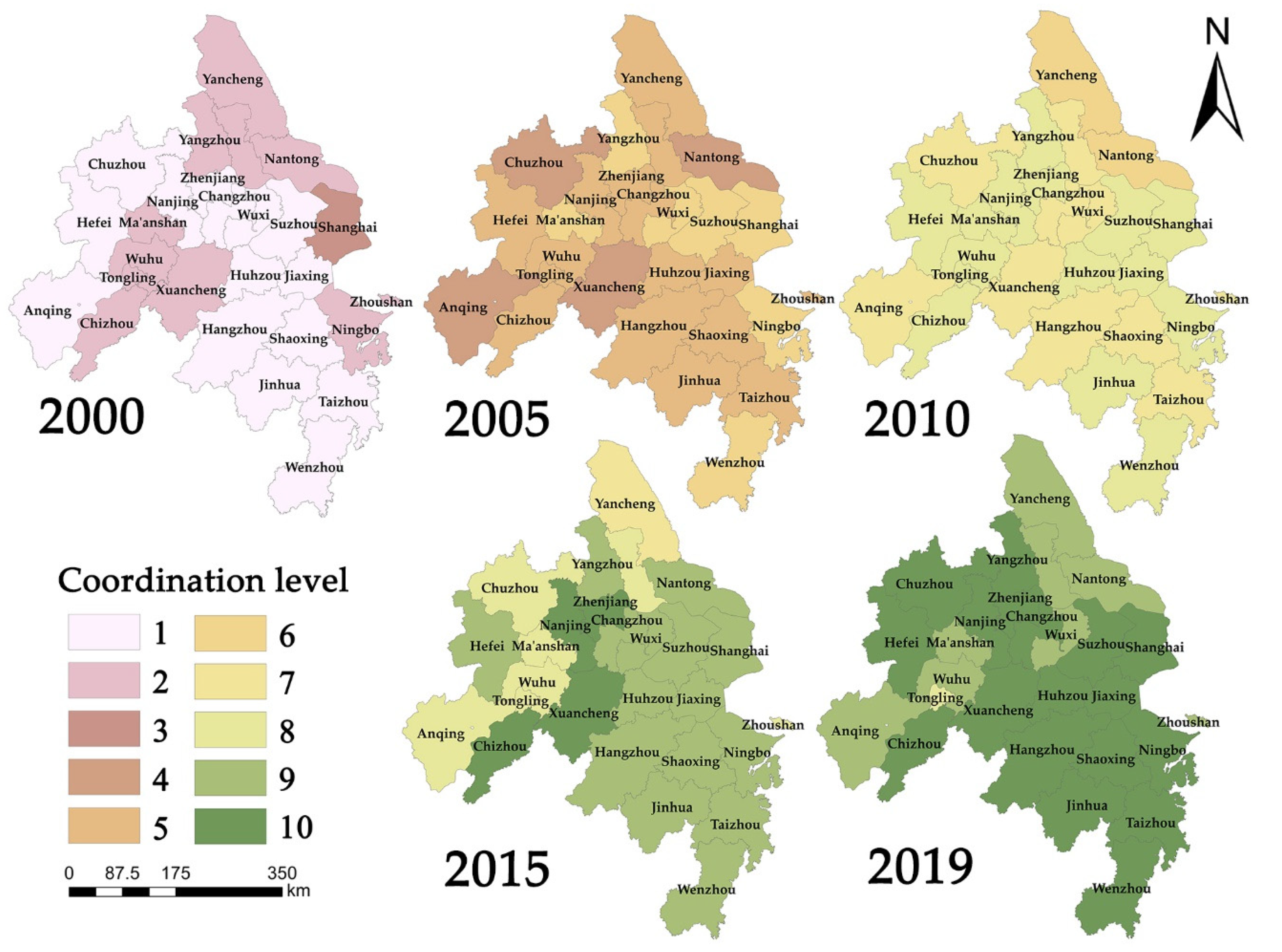
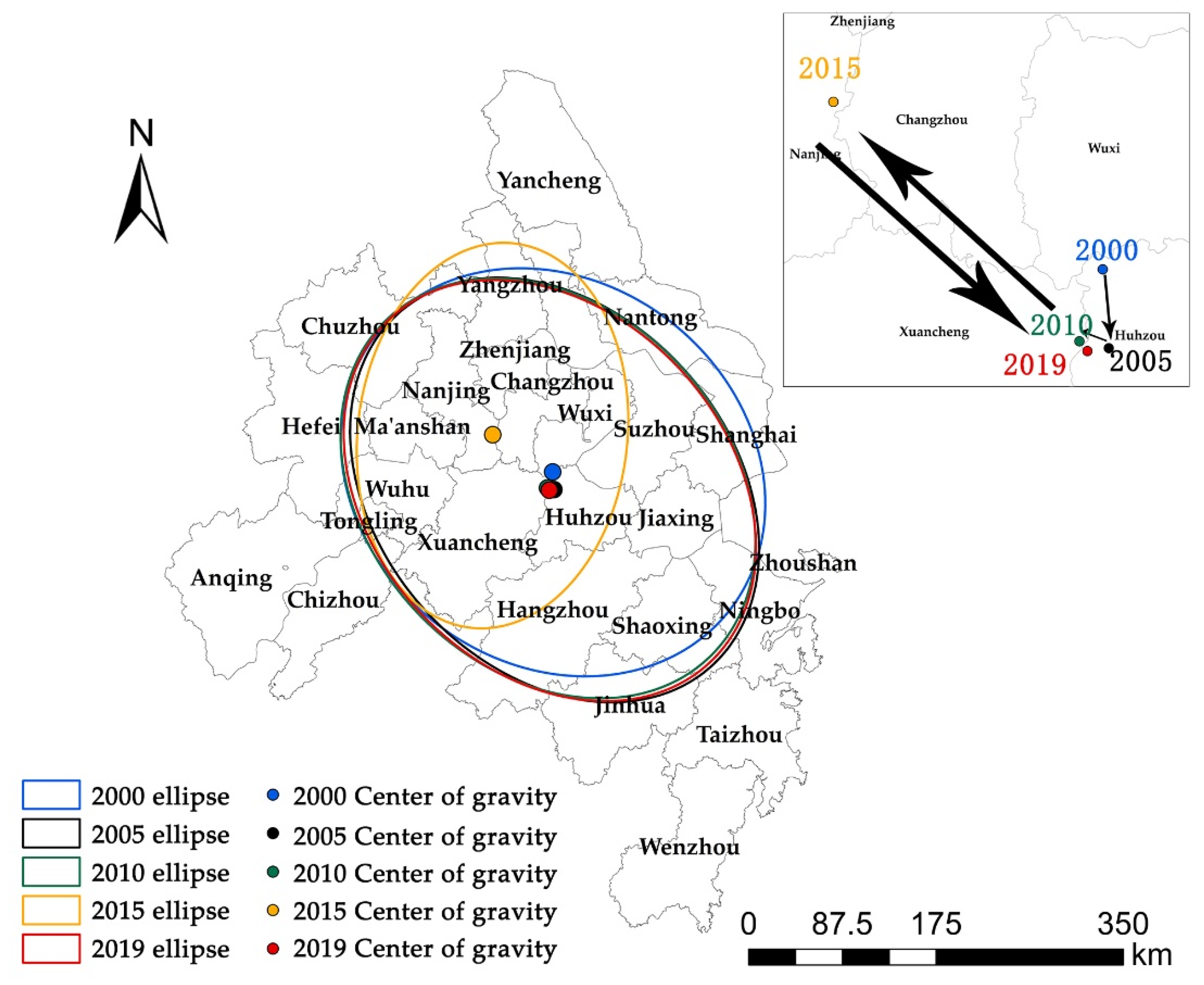
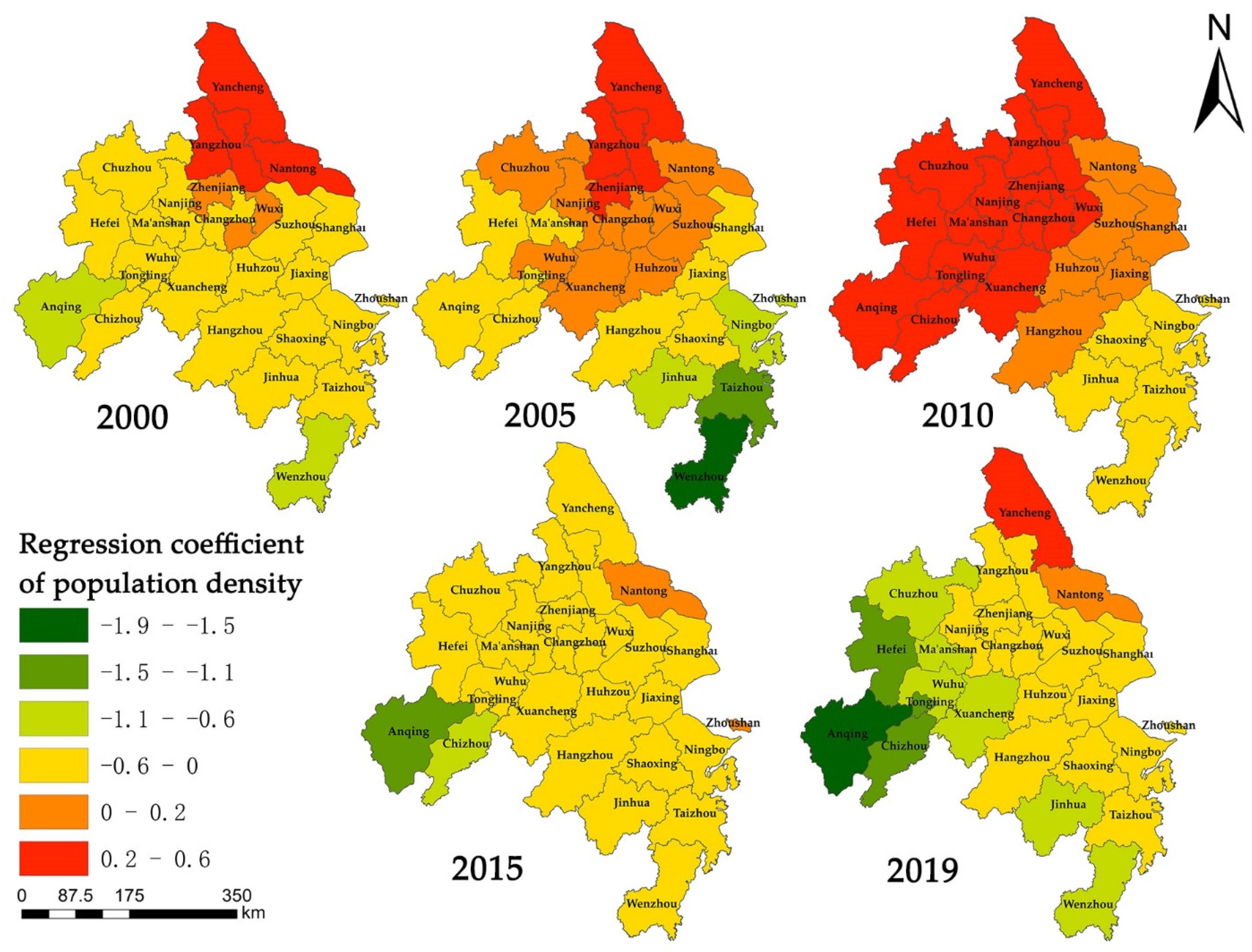

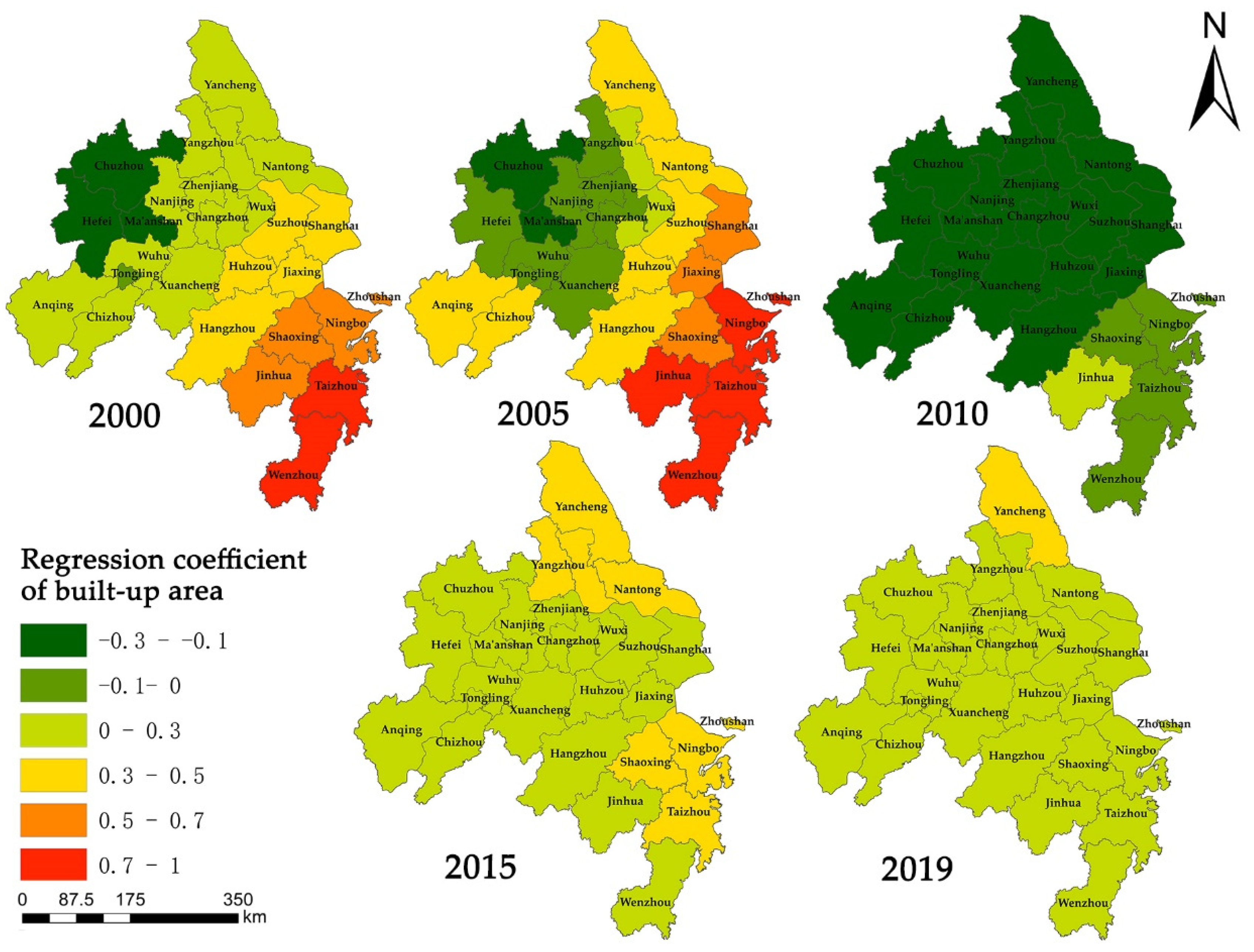
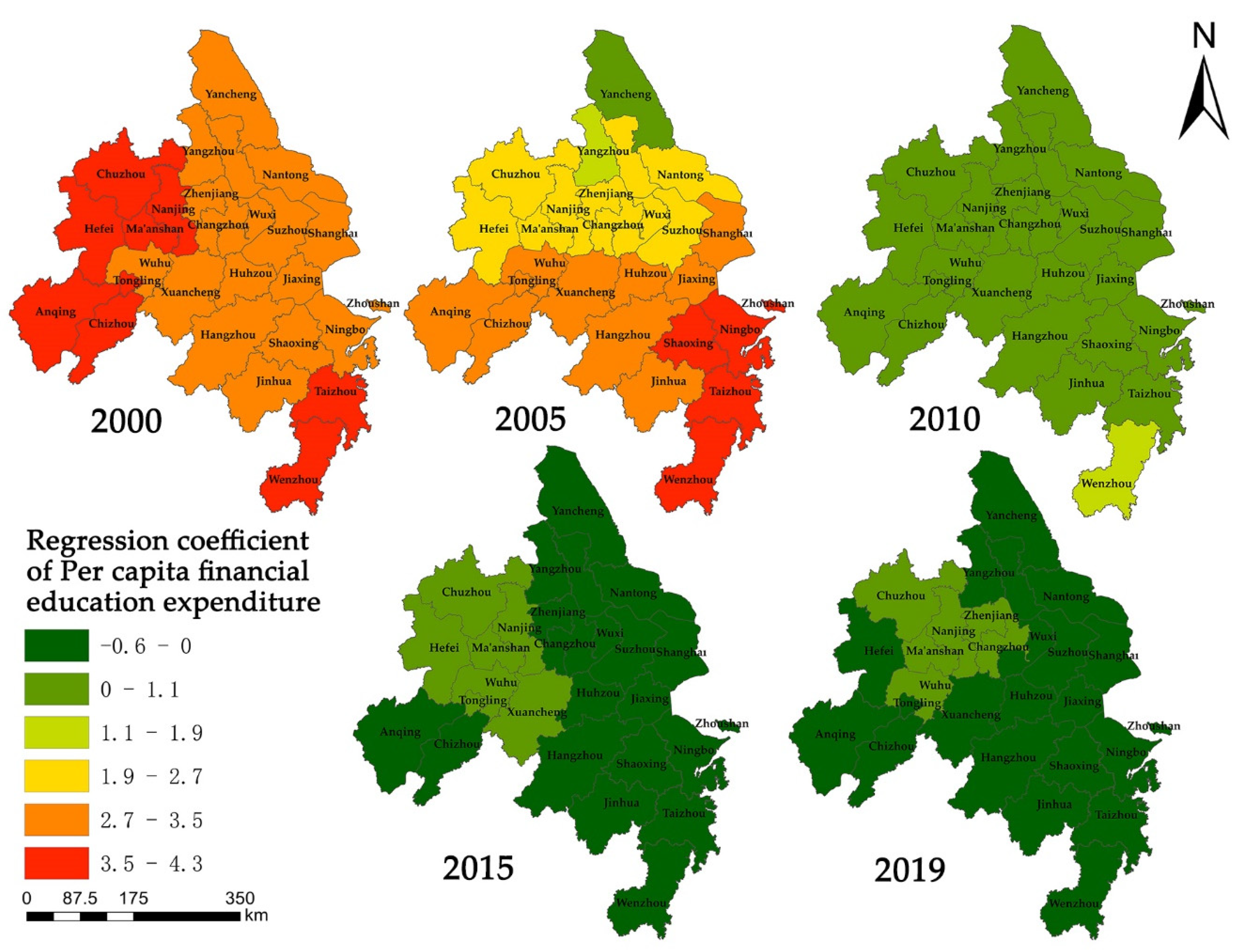
| Data | Resolution | Year | URL | ||||||
|---|---|---|---|---|---|---|---|---|---|
| 1999 | 2000–2003 | 2004–2009 | 2010–2011 | 2012–2013 | 2014–2019 | ||||
| Nighttime light remote sensing data | DMSP/OLS | 2.7 km | F14 | F15 | F16 | F18 | https://www.ngdc.noaa.gov/ (accessed on: 28 December 2021) | ||
| NPP/VIIRS | 400 m | VCMCFG | VCMSLCFG | ||||||
| Social and economic data | Statistical Yearbook | China City Statistical Yearbook, Jiangsu Statistical Yearbook, Zhejiang Statistical Yearbook, Anhui Statistical Yearbook, Shanghai Statistical Yearbook, Statistical Communique of the People’s Republic of China National Economic and Social Development et al. | https://data.cnki.net/ (accessed on: 20 December 2021) | ||||||
| First-Grade Indexes | Second-Grade Indexes | Unit | Weight |
|---|---|---|---|
| Population urbanization | Urbanization rate of permanent population | % | 0.199 |
| Proportion of the labor force in the secondary and tertiary industries | % | 0.137 | |
| Population density | Person/km2 | 0.663 | |
| Economic urbanization | Per capita GDP | Yuan/Person | 0.151 |
| Proportion of the output value of the secondary and tertiary industries | % | 0.007 | |
| Per km2 fixed asset investment | 10k Yuan/km2 | 0.251 | |
| Per capita urban consumption number | Yuan/Person | 0.144 | |
| Fiscal revenue per km2 | 10k Yuan/km2 | 0.447 | |
| Land urbanization | Built-up area | km2 | 0.276 |
| Urban land-use rate | m2 | 0.440 | |
| Per capita urban living area | % | 0.144 | |
| Per capita urban road area | m2/Person | 0.141 | |
| Social urbanization | Per 10,000 college students | Person | 0.200 |
| Number of health technicians per 10,000 people | Person | 0.072 | |
| Annual total passengers of public transportation | 10k person time | 0.517 | |
| Per capita financial education expenditure | Yuan/Person | 0.160 | |
| Per capita Public green area | m2 | 0.050 |
| Coordinated Development Stage | D Value Interval | Coordination Level | Degree of Coordination |
|---|---|---|---|
| Disorder stage | (0.0, 0.1) | 1 | Extreme disordered |
| [0.1, 0.2) | 2 | Serious disordered | |
| [0.2, 0.3) | 3 | Moderate disordered | |
| [0.3, 0.4) | 4 | Mild disordered | |
| [0.4, 0.5) | 5 | On the verge of disordered | |
| Coordination stage | [0.5, 0.6) | 6 | Barely coordinated |
| [0.6, 0.7) | 7 | Primary coordinated | |
| [0.7, 0.8) | 8 | Intermediately coordinated | |
| [0.8, 0.9) | 9 | Well-coordinated | |
| [0.9, 1.0) | 10 | High quality coordinated |
| Year | PU | EU | LU | SU | C | T | D | Degree of Coordination |
|---|---|---|---|---|---|---|---|---|
| 2000 | 0.010 | 0.001 | 0.001 | 0.004 | 0.686 | 0.002 | 0.033 | Extremely disordered |
| 2001 | 0.060 | 0.014 | 0.054 | 0.041 | 0.878 | 0.042 | 0.193 | Seriously disordered |
| 2002 | 0.105 | 0.033 | 0.324 | 0.093 | 0.727 | 0.139 | 0.317 | Mildly disordered |
| 2003 | 0.165 | 0.059 | 0.164 | 0.119 | 0.927 | 0.127 | 0.343 | Mildly disordered |
| 2004 | 0.246 | 0.094 | 0.215 | 0.203 | 0.94 | 0.189 | 0.422 | On the verge of disordered |
| 2005 | 0.302 | 0.129 | 0.280 | 0.258 | 0.951 | 0.242 | 0.48 | On the verge of disordered |
| 2006 | 0.379 | 0.167 | 0.319 | 0.297 | 0.958 | 0.29 | 0.527 | Barely coordinated |
| 2007 | 0.462 | 0.217 | 0.382 | 0.359 | 0.965 | 0.355 | 0.585 | Barely coordinated |
| 2008 | 0.527 | 0.268 | 0.447 | 0.434 | 0.971 | 0.419 | 0.638 | Primary coordinated |
| 2009 | 0.549 | 0.316 | 0.523 | 0.499 | 0.978 | 0.472 | 0.679 | Primary coordinated |
| 2010 | 0.732 | 0.391 | 0.588 | 0.569 | 0.976 | 0.57 | 0.746 | Intermediately coordinated |
| 2011 | 0.695 | 0.471 | 0.644 | 0.619 | 0.99 | 0.607 | 0.775 | Intermediately coordinated |
| 2012 | 0.693 | 0.543 | 0.684 | 0.677 | 0.995 | 0.649 | 0.804 | Well-coordinated |
| 2013 | 0.839 | 0.609 | 0.751 | 0.724 | 0.994 | 0.731 | 0.852 | Well-coordinated |
| 2014 | 0.786 | 0.685 | 0.796 | 0.774 | 0.998 | 0.76 | 0.871 | Well-coordinated |
| 2015 | 0.871 | 0.757 | 0.835 | 0.810 | 0.999 | 0.818 | 0.904 | High-quality coordinated |
| 2016 | 0.858 | 0.815 | 0.831 | 0.829 | 1 | 0.833 | 0.913 | High-quality coordinated |
| 2017 | 0.902 | 0.884 | 0.867 | 0.857 | 1 | 0.877 | 0.937 | High-quality coordinated |
| 2018 | 0.946 | 0.939 | 0.931 | 0.931 | 1 | 0.937 | 0.968 | High-quality coordinated |
| 2019 | 0.999 | 0.999 | 0.999 | 0.988 | 1 | 0.996 | 0.998 | High-quality coordinated |
| Parameter Name | Value |
|---|---|
| Residual Squares | 0.063482 |
| Sigma | 0.021685 |
| AICc | 30.1291 |
| R2 | 0.994946 |
| Adjusted R2 | 0.994211 |
| Spatiotemporal Distance Ratio | 1.70756 |
| 2000–2019 | Minimum | 1/4 Quantile | Median | 3/4 Quantile | Maximum | Mean Value | |
|---|---|---|---|---|---|---|---|
| PU | −0.682 | −0.229 | −0.031 | 0.195 | 0.486 | −0.028 | |
| −0.321 | −0.031 | 0.018 | 0.075 | 1.262 | 0.039 | ||
| −1.894 | −0.443 | −0.142 | 0.088 | 0.632 | −0.193 | ||
| EU | −2.364 | −0.087 | −0.012 | 0.159 | 1.204 | −0.030 | |
| −0.444 | −0.116 | −0.054 | 0.198 | 0.381 | 0.006 | ||
| −1.512 | −0.285 | 0.027 | 0.124 | 1.482 | −0.004 | ||
| −1.232 | 0.094 | 0.371 | 0.514 | 2.066 | 0.337 | ||
| −6.550 | −0.773 | −0.106 | 0.120 | 1.169 | −0.595 | ||
| LU | −0.287 | −0.036 | 0.178 | 0.290 | 0.934 | 0.148 | |
| −0.162 | 0.034 | 0.202 | 0.496 | 1.050 | 0.254 | ||
| −0.187 | −0.022 | 0.093 | 0.153 | 0.327 | 0.078 | ||
| −0.014 | 0.151 | 0.219 | 0.371 | 0.817 | 0.295 | ||
| SU | −0.107 | 0.014 | 0.155 | 0.247 | 0.398 | 0.136 | |
| −1.320 | −0.361 | −0.133 | 0.005 | 0.293 | −0.205 | ||
| −1.024 | −0.810 | −0.231 | 0.228 | 0.497 | −0.287 | ||
| −0.507 | −0.047 | 0.687 | 2.877 | 4.250 | 1.298 | ||
| −0.061 | 0.088 | 0.129 | 0.206 | 0.316 | 0.137 | ||
Publisher’s Note: MDPI stays neutral with regard to jurisdictional claims in published maps and institutional affiliations. |
© 2022 by the authors. Licensee MDPI, Basel, Switzerland. This article is an open access article distributed under the terms and conditions of the Creative Commons Attribution (CC BY) license (https://creativecommons.org/licenses/by/4.0/).
Share and Cite
Tao, F.; Tang, G.; Wu, Y.; Zhou, T. Spatiotemporal Heterogeneity and Driving Mechanism of Co-Ordinated Urban Development: A Case Study of the Central Area of the Yangtze River Delta, China. Sustainability 2022, 14, 5105. https://doi.org/10.3390/su14095105
Tao F, Tang G, Wu Y, Zhou T. Spatiotemporal Heterogeneity and Driving Mechanism of Co-Ordinated Urban Development: A Case Study of the Central Area of the Yangtze River Delta, China. Sustainability. 2022; 14(9):5105. https://doi.org/10.3390/su14095105
Chicago/Turabian StyleTao, Fei, Guoan Tang, Yihao Wu, and Tong Zhou. 2022. "Spatiotemporal Heterogeneity and Driving Mechanism of Co-Ordinated Urban Development: A Case Study of the Central Area of the Yangtze River Delta, China" Sustainability 14, no. 9: 5105. https://doi.org/10.3390/su14095105







